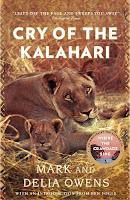Cry of the Kalahari by Mark and Delia Owens
Author: Mark & Delia Owens
Title: Cry of the Kalahari
Publisher: Corsair
Published: 1984
Pages: 480
Genre: Non Fiction / wildlife
Carrying little more than a change of clothes and a pair of binoculars, two young Americans, Mark and Delia Owens caught a plane to Africa, bought a thirdhand Land Rover, and drove deep into the Kalahari Desert. There they lived for seven years, in an unexplored area with no roads, no people, and no source of water for thousands of square miles. In this vast wilderness, the Owenses began their zoology research, working along with animals that had never before been exposed to humans. An international bestseller on its original release, Cry of the Kalahari is the story of the Owens's life with lions, brown hyenas, jackals, giraffes, and the many other creatures they came to know. It is also a gripping account of how they survived the dangers of living in one of the last and largest pristine areas on Earth.
Ever since I was a child I have loved the natural world. I was fascinated by all the documentary series that were aired on British TV. A love that has carried on into adulthood. So having just watched a documentary called Into The Okavango I went to my local bookstore in search of more about this amazing place. Well as it turns out they were somewhat light on books about the subject but what they did have was a slightly neglected copy of Cry of The Kalahari. Not having ever heard of it I skimmed through the inside of the dust jacket. It imminently sounds like just the sort of book to keep me glued to the pages for a good many hours. How could I not resist reading about some of the animals I had spent so long lovingly watching on the TV for so many years. I was also curious to hear about their study of Hyenas. They strike me as an animal that is much misunderstood by the human world. I suspect in part due to how they look? I have only seen them once up close and as much as I would love to say it was a magical experience seeing them running in circles around a concrete enclosure left me feeling heartbroken for a group of animals that should be free to roam the wilds. Not contained for humans to stare at for entertainment.
Setting off on their adventure I must admit they seemed very naive about the whole thing. The thought now of just packing up a few things add heading off to another country with little planning and preparation seems like a fool's errand. But this they did and to their credit, they managed to make it work for the longest time. They collected data that to the best of my knowledge at the time did not exist on these amazing animals. I was fascinated by how their work evolved over time. With the passing of the season and their interaction with each of the local prides, it swayed the focus as new information came to light. It captivated me to be able to read about this process as it unfurled. More often than not we get to see the end results with little time devoted to how they got there. For me, in such works, the process is just as important as the shinny results edited for the nine-a-clock news.
Whilst the animals that are contained within these pages are no doubt long since dead I got to feel like I knew them a little. What made them tick and their drive to keep the bloodlines alive. With this comes an uncompromising work that never flinches away from the harsh realities of the natural world. Maybe too many animated tales on the big screen have sugarcoated the world for us. But within these pages, there is no such luck as much as we want all of them to survive nature is indifferent. With that said this book and their research would not be what it is had they chosen to show an edited version of the world. We rely on such work to educate us on what came before and to help us better understand the world we live in. The Owens by no means did everything right and at times I felt myself strongly disagree with certain actions they took. When it comes to how we gather data on wild animals times have moved on and systems are in place for how to do such activities. It is just worth remembering that in the seventies when all this took place. Nature conservation was in its infancy. And how animals were observed seems to have been the dealers' choice.
There are many wonderful stories to be found here from waking up to lions in their camp to Heynas becoming fairly nonplus about the Owen's being around them. And I loved delving into each of them seeing how in many ways these beautiful animals are not all that different from us. The work they did with the Heynas was especially reverting for me and I can safely say that I came away with a much great understanding of how they exist in the world. And a thurst to go and discover more about them. It is far too easy whilst reading this to feel the heat of the African sun on your back and the dust between your fingers. But usually, within a few pages, we are reminded of the reality of surviving miles away from nowhere. Personally, as much as the thought of doing what they did fascinates me I know I'm not built for such a place and would have run from the heat long before they did.
This was a book that totally took me in from the start and refused to let me go. I loved reading about the animals and places. Only made more vivid by the scattering of photos taken by the couple during their time in the Kalahari. These deep rich colors swirling around inside my head made the experience all the more enjoyable. It is a book that I could not only talk about for a great many hours but would also be happy to recommend to many others.



Comments
Post a Comment